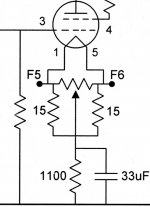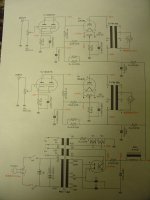I use the JJ 2A3-40 in my single ended amplifiers and find them to be outstanding tubes and well worth the cost, which is rather modest actually. I have always known that it was not good engineering to connect the wiper of a 50 ohm "humbucking" pot to the cathode resistor without bypassing it, because the 50mA or 60mA of current has to go through the wiper of the pot. It wasn't until I got off my lazy butt and corrected the situation that I discovered how important it was to the sound of the amp. I had always had a low level hum from the amp and assumed the power supply had insufficient filtering.
I quite randomly found a bag of a couple dozen 15 ohm 2W resistors on epay and bought them. I installed the resistors from each end of the pot to the wiper allowing the cathode current two paths around the wiper. The change in hum was dramatic! So this is just a reminder: if you AC heat your 2A3 filaments (that's a 46 in the drawing) you need to bypass the wiper with 10 ohm or 15 ohm resistors for best performance and lowest hum.
I quite randomly found a bag of a couple dozen 15 ohm 2W resistors on epay and bought them. I installed the resistors from each end of the pot to the wiper allowing the cathode current two paths around the wiper. The change in hum was dramatic! So this is just a reminder: if you AC heat your 2A3 filaments (that's a 46 in the drawing) you need to bypass the wiper with 10 ohm or 15 ohm resistors for best performance and lowest hum.
Attachments
Actually, you can do a wee bit better. My standard approach for the 45 and 2A3 hum balancing is a split technique. I use a 100-ohm WW linear pot for the hum adjustment and use a pair of 12-ohm 1% 2W resistors for the pads (each pot end to the wiper) as you show in your schematic. As the balance pot is effectively split in two halves, you have a pair of 50 ohm resistors (pot at mid-point) in parallel (25 ohms) plus the pair of 12 ohm resistors in parallel (6 ohms) for a total inline resistance of 5.35 ohms (your setup = 5.75 ohms). The added advantage to using the 100 ohm pot is a bit wider adjustment range versus pot rotation, so the null point is wider and easier to dial in.
The split balance technique I use requires a center-tapped filament supply for the 45 or 2A3 tube. Instead of having the cathode bias resistor in parallel with the bypass cap, you tie the cathode bias resistor to the transformer center-tap and only have the bypass cap wired to the hum balance pot. This give you a fixed center-point for DC balance across the DHT filament and an adjustable balance for AC only. You can also extend by using a second pot for DC balance is you like. Try it... I've found it works better and you can get slightly lower hum levels with good tubes.
Regards, KM
The split balance technique I use requires a center-tapped filament supply for the 45 or 2A3 tube. Instead of having the cathode bias resistor in parallel with the bypass cap, you tie the cathode bias resistor to the transformer center-tap and only have the bypass cap wired to the hum balance pot. This give you a fixed center-point for DC balance across the DHT filament and an adjustable balance for AC only. You can also extend by using a second pot for DC balance is you like. Try it... I've found it works better and you can get slightly lower hum levels with good tubes.
Regards, KM
Thanks. How about the opt transformer, how many watts preferred? On power transformer, is 800v ct at 230mA is enough?
D3A driving the Shuguang 2A3's
you will be surprised that these Shuguangs biased exactly alike,
250 volts at 60mA each....
one amp used rc to bias the D3a, the other red LED and diode,
the owner can not tell them apart...
one amp used the 2.5 volt center tapped heaters,
the other used the humdinger pot, i set the humdinger at mid span
and upon powering up, i found out that i never had to touch it....
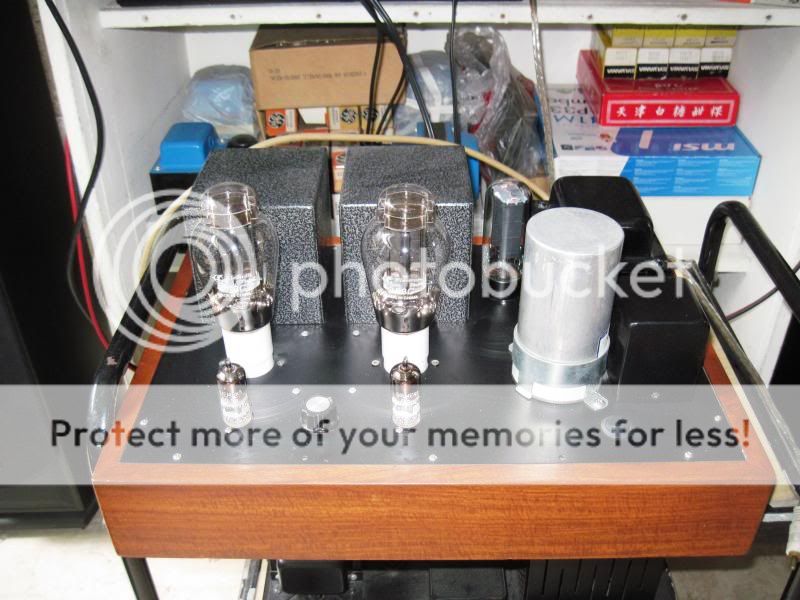
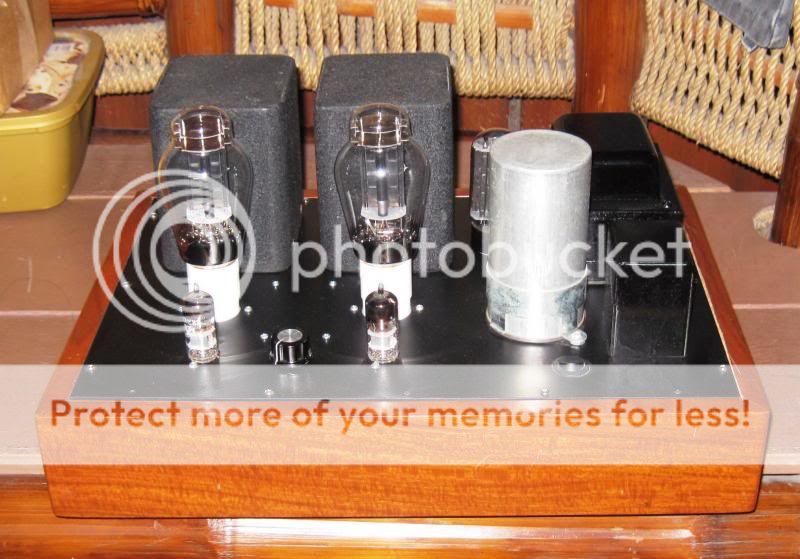
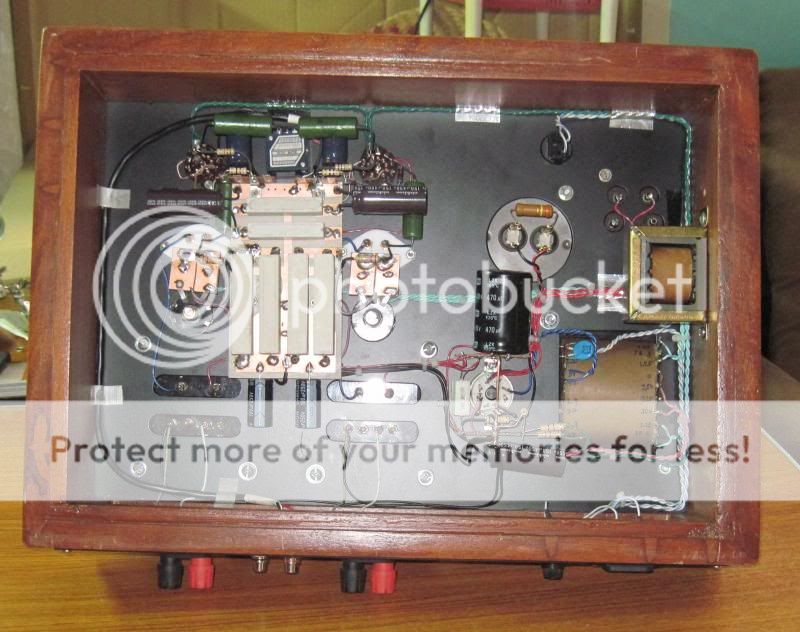
you will be surprised that these Shuguangs biased exactly alike,
250 volts at 60mA each....
one amp used rc to bias the D3a, the other red LED and diode,
the owner can not tell them apart...
one amp used the 2.5 volt center tapped heaters,
the other used the humdinger pot, i set the humdinger at mid span
and upon powering up, i found out that i never had to touch it....



Shishido 2A3 Hum Pot
I would like to know, how many watts is the hum pot (10-ohm) for this Shishido 2A3 amp? Thanks.
I would like to know, how many watts is the hum pot (10-ohm) for this Shishido 2A3 amp? Thanks.
I am referring to KM post:
"The split balance technique I use requires a center-tapped filament supply for the 45 or 2A3 tube. Instead of having the cathode bias resistor in parallel with the bypass cap, you tie the cathode bias resistor to the transformer center-tap and only have the bypass cap wired to the hum balance pot. This give you a fixed center-point for DC balance across the DHT filament and an adjustable balance for AC only. You can also extend by using a second pot for DC balance is you like. Try it... I've found it works better and you can get slightly lower hum levels with good tubes."
Is there any diagram to show how to connect this split balance??
"The split balance technique I use requires a center-tapped filament supply for the 45 or 2A3 tube. Instead of having the cathode bias resistor in parallel with the bypass cap, you tie the cathode bias resistor to the transformer center-tap and only have the bypass cap wired to the hum balance pot. This give you a fixed center-point for DC balance across the DHT filament and an adjustable balance for AC only. You can also extend by using a second pot for DC balance is you like. Try it... I've found it works better and you can get slightly lower hum levels with good tubes."
Is there any diagram to show how to connect this split balance??
Thanks. How about the opt transformer, how many watts preferred? On power transformer, is 800v ct at 230mA is enough?
Difficult to say. It depends the working conditions you consider.
I mean OPT rating 4 watt at 20 Hz with induction of 7000 gauss has plenty of headroom for this project.
But very few designers rate their OPT so conservatively.
I am referring to KM post:
"The split balance technique I use requires a center-tapped filament supply for the 45 or 2A3 tube. Instead of having the cathode bias resistor in parallel with the bypass cap, you tie the cathode bias resistor to the transformer center-tap and only have the bypass cap wired to the hum balance pot. This give you a fixed center-point for DC balance across the DHT filament and an adjustable balance for AC only. You can also extend by using a second pot for DC balance is you like. Try it... I've found it works better and you can get slightly lower hum levels with good tubes."
Is there any diagram to show how to connect this split balance??
simply a center tapped 2.5 volts filament winding, said another way, 1.25-0-1.25 volts ac...
2A3 Shishido L-W
About the cathode resistor
On schematics says 3000 Ohms for 2A3, for 45 tube swing how many the cathode resistor can be?
Plus the change on OPT impedance, any other change on sch for 45 tube?
About the cathode resistor
On schematics says 3000 Ohms for 2A3, for 45 tube swing how many the cathode resistor can be?
Plus the change on OPT impedance, any other change on sch for 45 tube?
I like the chance of using either 2a3 or 45 in an amp. I've struggled to find a good schematic. I'll watch this thread.
I too would like to see schematics for what needs to be changed to accommodate both tubes. I think it's a simple thing to insert a switch.....
I too would like to see schematics for what needs to be changed to accommodate both tubes. I think it's a simple thing to insert a switch.....
I like the chance of using either 2a3 or 45 in an amp. I've struggled to find a good schematic. I'll watch this thread.
I too would like to see schematics for what needs to be changed to accommodate both tubes. I think it's a simple thing to insert a switch.....
Loftin-White amplifiers are by definition not 2a3/45 switchable.
Last edited:
I've seen a few examples of folks who have built an amp allowing the user go switch between 2a3, 45, 50, 300B. The amp's have toggles all over the place. Obviously if one were to build a 45 amp, you could drop in 2A3's but not to good affect. I will try and find some drawings.
Loftin-White amplifiers are by definition not 2a3/45 switchable.
I like the chance of using either 2a3 or 45 in an amp. I've struggled to find a good schematic. I'll watch this thread.
I too would like to see schematics for what needs to be changed to accommodate both tubes. I think it's a simple thing to insert a switch.....
At least to make your amp 2A3/45 switchable you will have to accept some compromise.
A "universal" OPT will either be more expensive of an equivalent specialized unit or less performant at an equivalent price.
Cathode resistor should not be a big issue. You could use a main resistor for 45 and add a switchable second cathode resistor paralleled with the main one to get the appropriate value for a 2A3.
Ciro
I have only built one amp, which means I'm new. George at Tubelab said the same about a universal opt. I have collected a dozen 45 tubes so fir now I will concentrate on optimizing the circuit for that tube only.
I have only built one amp, which means I'm new. George at Tubelab said the same about a universal opt. I have collected a dozen 45 tubes so fir now I will concentrate on optimizing the circuit for that tube only.
Ciro
I have only built one amp, which means I'm new. George at Tubelab said the same about a universal opt. I have collected a dozen 45 tubes so fir now I will concentrate on optimizing the circuit for that tube only.
Good idea 😉
45 sounds so good...
2A3 to 45
Hello to all
I have 2A3 amp with Tango FW-20S OT and it's sounds amazing. Looks like it is Shishido Loftin- White. I would like to try this amp with 45 tubes if it is possible. FW-20S are universal and have 5K secondary. What else is requied to change to make this baby sing with my favorite triode, 45. I've attached schematics I've received with amp. Thanks in advance,
Ben.
Hello to all
I have 2A3 amp with Tango FW-20S OT and it's sounds amazing. Looks like it is Shishido Loftin- White. I would like to try this amp with 45 tubes if it is possible. FW-20S are universal and have 5K secondary. What else is requied to change to make this baby sing with my favorite triode, 45. I've attached schematics I've received with amp. Thanks in advance,
Ben.
Attachments
I've seen a few examples of folks who have built an amp allowing the user go switch between 2a3, 45, 50, 300B. The amp's have toggles all over the place. Obviously if one were to build a 45 amp, you could drop in 2A3's but not to good affect. I will try and find some drawings.
Hello !!
You can NOT add switches to a high quality SET DC amp and expect it to perform well, or, at least optimally.
Just because you have " seen it done before " does NOT mean this is the optimal way to build an amplifier.
One must question each and every part in the build, and ask yourself (a) is this part needed and (b) is each part good enough in quality, to convey the music back to me ?
Jeff
Member
Joined 2009
Paid Member
Hey Jeff - how's a good switch any different, electrically speaking, from the contacts between tube pins and tube sockets ? - should all be good in the end if good parts are used, as you suggest.
- Home
- Amplifiers
- Tubes / Valves
- Shishido/Loftin-White 2A3/45 Extasy..
